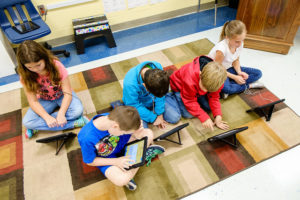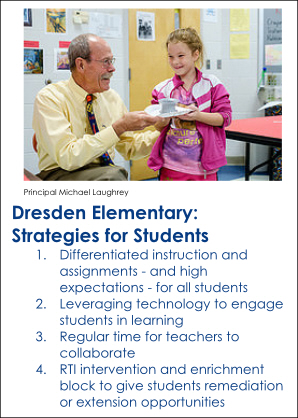What is your level of effort?
What is the best that you can give?
These are questions asked of students daily at SCORE Prize winner Dresden Elementary, according to fourth-grade teacher Honey Cantrell. Students are encouraged to give “their absolute.” And in classrooms driven by creative, engaging, and differentiated instruction, teachers know that students’ best work will vary highly between individuals.
Dresden Elementary, serving grades PK-4 in Weakley County Schools in northwest Tennessee, has helped its primarily low-income, rural population of students achieve remarkable results. The school posts high three-year growth marks on the Tennessee Value Added Assessment System (TVAAS) growth, and Dresden students have met or outpaced statewide averages on Tennessee Comprehensive Assessment Program (TCAP) tests. About 70 percent of Dresden’s students are economically disadvantaged.
“They want to be here and they want to learn, and that’s what we get out of them,” said Melanie Needham, assistant principal and literacy leader. “We want Dresden Elementary to be a special place for kids. That’s everybody’s philosophy, from the principal to the cleaning staff.”
 Dresden educators have helped students succeed by empowering them to set and reach personalized learning goals. Starting with third-grade TCAP data, third- and fourth-grade students have data binders mapping out student progress and identifying incremental goals. The binders include report cards, important assignments, STAR reading reports, and TCAP practice results. Using binders, rather than a data wall, helps students focus on individual progress rather than peer comparisons.
Dresden educators have helped students succeed by empowering them to set and reach personalized learning goals. Starting with third-grade TCAP data, third- and fourth-grade students have data binders mapping out student progress and identifying incremental goals. The binders include report cards, important assignments, STAR reading reports, and TCAP practice results. Using binders, rather than a data wall, helps students focus on individual progress rather than peer comparisons.
Students at Dresden receive highly individualized instruction. The school’s Response to Instruction and Intervention time, referred to as “Paw Power” in honor of Dresden’s lion mascot, provides 45 minutes each day to work on individual academic needs. The lowest 20 percent of academic achievers, as well as special education students, receive specialized instruction. Higher performers receive enrichment, like small-group reading lessons for students in grades K-2. Third- and fourth-grade enrichment students rotate between areas of need, including intensive math lessons, novel studies, and keyboarding and computer skills. The small-group instruction is made possible by help throughout the building. Lessons are taught by staff members including counselors, media specialists, and a physical education teacher with two decades of experience teaching middle school math.
While the school has had intervention services in place for years, “Paw Power” debuted in Fall 2014. Ms. Needham said both lower and higher achieving students are making gains, and school leaders are hopeful for more TCAP improvements.
Differentiation strategies are also in play in every classroom throughout the day. Teaching is creative and engaging. Assignments often include both a uniform assessment portion as well as a personalized component, delivering enrichment or strengthening fundamentals as needed. Students are involved directly in lessons with iPads and Promethean boards, and teachers constantly strive to find new ways to engage their students.
 Delivery of fresh, innovative lessons is enabled by high-level staff collaboration. Each grade level has 45 minutes each day of common planning time, and grade-level and cross-collaborative meetings are scheduled on a regular basis. Dresden administrators are present in classrooms, watching for opportunities to share strategies. Lines of communication are kept open.
Delivery of fresh, innovative lessons is enabled by high-level staff collaboration. Each grade level has 45 minutes each day of common planning time, and grade-level and cross-collaborative meetings are scheduled on a regular basis. Dresden administrators are present in classrooms, watching for opportunities to share strategies. Lines of communication are kept open.
“Nobody is expected to come here and, as the old saying goes, shut their door and teach,” Ms. Needham said. “They plan collectively and lay out common work. Sometimes you can see the common thread from classroom to classroom. You can see where they have shared materials and resources. It makes them all stronger teachers to have a group of people they can go to for support.”
This collaborative culture has ramped up in the last few years, and Ms. Cantrell sees a direct link between this development and rising school TVAAS scores.
“Our lunches at this school are working lunches,” Ms. Cantrell said. “We collaborate on every single subject in every single grade. The culture of this school – it’s a community. I want to share what I’m doing with other teachers because I want to reach more students.”
Staff knowledge-sharing has been of particular help as the school has implemented technology from a state grant. Grades three and four have one iPad per student. Grades K-2 have five iPads per classroom.
Kids are “engaged to the extreme” when iPads are involved, Ms. Cantrell said. The NearPod app provides total class participation during lessons, and instant assessments allow teachers to see with the touch of a button how many students understood content. With many students lacking access to technology at home, iPad lessons are a powerful way to prepare kids for the future.
Principal Michael Laughrey regularly reminds the staff that school is, for some students, the best part of the day, and the school offers as many programs as possible to help kids connect.
Claire Oliver, parent of fourth- and second-grade students at Dresden, said it means a lot to her family to see Principal Laughrey and other staff members in front of the building each morning, shaking hands and giving high fives as students leave their cars.
“It’s little things like that that make me feel good as a parent and make my child want to go to school,” Ms. Oliver said.
Learn more about the successes at Dresden Elementary in this SCORE Prize video shot at the school.
